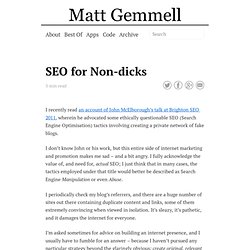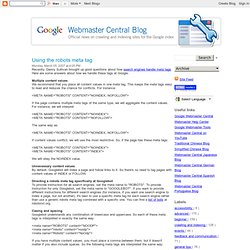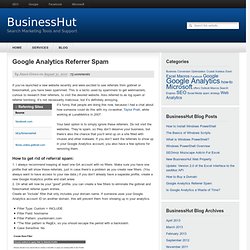

SEO Growth Hack: Piggy-Back For Fast Rankings. This guest post is by Pete Kennedy – SEO and Adwords Coach at Main Street ROI.

Pete has personally taught me everything I know about up-selling, SEO, conversion funnels and Sales Copy. I invited him to GMA to teach my readers about growing with SEO. The Myth. Headsmacking SEO Tip: Release Your Blog From It’s Subdomain. Is your blog locked in a subdomain?

This is one of the most common, headsmack inducing SEO issues I see on a regular basis. I’ve seen it being done on corporate sites and startups alike and it kills me every time. It’s especially headsmacking though when the company is awesome and their running a popular blog. What Every Programmer Should Know About SEO. Over the last few years since I started paying attention to SEO I have noticed many “developer guides to SEO”.

Largely, these guides are written by developers and not SEO experts. At this point, I am neither of those, but since I spent the last few years working for an SEO tools company, I managed to garner quite a bit of knowledge on the topic. Of course, the things I love about SEO, are the things I love about search – big data, fast performance, and interesting algorithms. Below I have compiled the minimum of amount of SEO knowledge a developer should have to properly optimize a website for search engine discovery. 11 Google Analytics Tricks to Use for Your Website. The Beginners Guide to Coding for SEO by SEO Takeaways. The New SEO Process (Quit Being Kanye) AOL Email Tax - Never Work. AMERICA ONLINE has announced that it may transformed its email support.

They intend on charging with regard to email to be able to assist slow down and even stop junk e-mail. Yelp SEO Analysis: Part Two. Here’s Part II from last week’s SEO analysis of Yelp.

Sorry it took so long. Yelp SEO Analysis: Part One. Relevant comments from Hacker News 'Basic SEO' post. Source: andrewljohnson 715 days ago | link 0.

Mine The Web's Socially-Tagged Links: Google Social Graph API Launched. Did you know there’s a way to tag links on pages to indicate social connections?

I’d heard about this vaguely, but you can bet there’s going to be much more public awareness and potential use, thanks to Google launching its new Google Social Graph API. Now available, the API allows developers to discover socially-labeled links on pages and generate connections between them.
Startup Dispatch. In September 2011, Matt Gemmell wrote an article, SEO for Non-Dicks . The gist of that article is this: be nice, write well, write often, and don’t fuck up the titles. It’s a good general guide for the SEO-clueless, though you could do far better by hanging out at the SEOMoz blog for a couple of weeks. The obverse exists as well: SEO for dicks. It essentially takes the gist of Matt’s approach, chews it up and vomits it out as a nauseating mess of link farms, spam, spun content, and general bullshit.
I don’t encourage it, neither do I advocate it. The Sorting Hat(s) Black, White and Grey: the three shades of SEO hats. SEO for Non-dicks. I recently read an account of John McElborough’s talk at Brighton SEO 2011, wherein he advocated some ethically questionable SEO (Search Engine Optimisation) tactics involving creating a private network of fake blogs.

I don’t know John or his work, but this entire side of internet marketing and promotion makes me sad – and a bit angry. I fully acknowledge the value of, and need for, actual SEO; I just think that in many cases, the tactics employed under that title would better be described as Search Engine Manipulation or even Abuse. I periodically check my blog’s referrers, and there are a huge number of sites out there containing duplicate content and links, some of them extremely convincing when viewed in isolation.
It’s sleazy, it’s pathetic, and it damages the internet for everyone. The key thing to understand is that the rules of SEO aren’t magic or arbitrary. SEOmoz Blog Featuring Search Engine Marketing Tactics & Strategies. Using the robots meta tag. Recently, Danny Sullivan brought up good questions about how search engines handle meta tags.

Here are some answers about how we handle these tags at Google. Multiple content values We recommend that you place all content values in one meta tag. This keeps the meta tags easy to read and reduces the chance for conflicts. For instance: If the page contains multiple meta tags of the same type, we will aggregate the content values. The same way as: If content values conflict, we will use the most restrictive. We will obey the NOINDEX value. Google Analytics Referrer Spam. If you’ve launched a new website recently and were excited to see referrals from golbnet or forexmarket, you have been spammed.

This is a tactic used by spammers to get webmasters, curious to research their referrers, to visit the desired website. Image Sitemaps - Webmaster Tools Help. Follow Webmaster Guidelines and best practices for publishing images to increase the likelihood that your images can be found in Image Search results. Additionally, you can use Google image extensions for sitemaps to give Google more information about the images available on your pages. Image sitemap information helps Google discover images that we might not otherwise find (such as images your site reaches with JavaScript code), and allows you to indicate images on your site that you want Google to crawl and index. You can use a separate sitemap to list images, or you can add image information to an existing sitemap. The following example shows a sitemap entry for the page which contains two images. Bienvenue sur Facebook. Performance, Implementation, and Design Notes.
The following notes are informative, not normative. Despite the appearance of words such as "must" and "should", all requirements in this section appear elsewhere in the specification. B.1 Notes on invalid documents This specification does not define how conforming user agents handle general error conditions, including how user agents behave when they encounter elements, attributes, attribute values, or entities not specified in this document. However, to facilitate experimentation and interoperability between implementations of various versions of HTML, we recommend the following behavior: If a user agent encounters an element it does not recognize, it should try to render the element's content.
We also recommend that user agents provide support for notifying the user of such errors. Since user agents may vary in how they handle error conditions, authors and users must not rely on specific error recovery behavior. B.2 Special characters in URI attribute values. Online identity management. Online identity management (OIM) also known as online image management or online personal branding or personal reputation management (PRM) is a set of methods for generating a distinguished Web presence of a person on the Internet. Internet marketing. In 2011, Internet advertising revenues in the United States surpassed those of cable television and nearly exceeded those of broadcast television.[1]:19 In 2013, Internet advertising revenues in the United States totaled $42.8 billion, a 17% increase over the $36.57 billion in revenues in 2012.[2]:4–5 U.S. internet ad revenue hit a historic high of $20.1 billion for the first half of 2013, up 18% over the same period in 2012.[3] Online advertising is widely used across virtually all industry sectors.[1]:16 Many common online advertising practices are controversial and increasingly subject to regulation.
Social media optimization. Social media optimization (SMO) is the use of a number of social media outlets and communities to generate publicity to increase the awareness of a product, brand or event. Types of social media involved include RSS feeds, social news and bookmarking sites, as well as social networking sites, such as Twitter, and video and blogging sites. SMO is similar to search engine optimization in that the goal is to generate traffic and awareness for a website. In general, social media optimization refers to optimizing a website and its content in terms of sharing across social media and networking sites. Relationship with search engine optimization[edit] Social media optimization is becoming an increasingly important factor in search engine optimization, as search engines are increasingly utilizing the recommendations of users of social networks such as Facebook, Twitter, YouTube and Google+ to rank pages in the search engine result pages. Search engine marketing.
Search engine marketing (SEM) is a form of Internet marketing that involves the promotion of websites by increasing their visibility in search engine results pages (SERPs) through optimization and advertising.[1] SEM may use search engine optimization (SEO), which adjusts or rewrites website content to achieve a higher ranking in search engine results pages, or use pay per click (PPC) listings.[2] Market[edit] In 2012, North American advertisers spent US$19.51 billion on search engine marketing. The largest search engine marketing (SEM) vendors were Google AdWords, Bing Ads,[3] and Baidu. Search engine optimization.
As an Internet marketing strategy, SEO considers how search engines work, what people search for, the actual search terms or keywords typed into search engines and which search engines are preferred by their targeted audience. Optimizing a website may involve editing its content, HTML and associated coding to both increase its relevance to specific keywords and to remove barriers to the indexing activities of search engines.